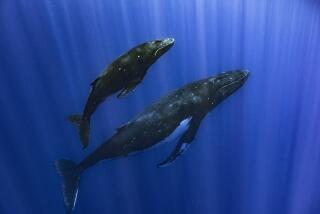Study of Whistles Suggests Dolphin Communication
- Share via
WASHINGTON — Bottlenose dolphins--the sort famous as performers in marine entertainment parks--may have a social communication system so complex that they can address one another individually by whistling the cetacean equivalent of “Yo, Flipper!”
That’s the conclusion of researcher Vincent M. Janik, who used an array of high-tech underwater microphones to record the distinctive “signature” whistles of wild dolphins off the coast of Scotland and monitored the way one animal imitated the other’s signature in an apparent call-response behavior.
The phenomenon, familiar among dolphins in captivity, has only begun to be studied in the wild. Its confirmation is a major step toward determining whether, and to what extent, the animals employ a form of language.
Janik’s findings appear to be “a good demonstration of intentional communication with a specific individual using learned vocal signals,” said Georgetown University biologist Janet Mann, who studies dolphin behavior and ecology in Australia.
Within the first year of life, each dolphin calf develops a unique personal sound signal made up of a pattern of rising and falling tones. Researchers have known for years that captive dolphins are capable of memorizing and mimicking the acoustic signatures of other members of their pods, a process called “whistle matching.” But whether this phenomenon is simply imitation, or a genuine effort at individual-to-individual communication, has been unclear.
Janik designed an experiment in which he listened to see if one wild dolphin would “whistle match” the signal of another nearby dolphin within a short enough time span to suggest that the animals were attempting to address one another.
Using six hydrophones, he recorded and analyzed nearly five hours of sounds made by a dozen dolphins in Scotland’s Moray Firth, near Loch Ness. Janik found dozens of instances in which a dolphin separated by as much as one-third of a mile from its neighbor would exactly match the sender’s whistle pattern, usually within less than one second.
An accurate whistle match within a time interval that brief, Janik writes in today’s issue of the journal Science, “is indicative of animals addressing each other individually.” If so, the conversation might signal aggression or friendship, or serve to “signal alliance membership to third parties”; that is, dolphins that were not part of the same group.
No additional communication besides the whistle imitation was observed. But even that kind of relatively simple vocal matching or labeling of individuals--common in birds but never observed in nonhuman terrestrial mammals--”has been hypothesized to have been an important step in the evolution of human language,” Janik wrote. The new results “show that reaching that step can be achieved in very different environments.”
Dolphins in captivity are fast and adept learners, quickly identifying certain artificial sound patterns with specific behaviors. According to some reports, they can respond to “sentences” with as many as four or five components. For example, when a human gives the command “surfboard-right-Frisbee-fetch,” the animal will then choose the Frisbee on its right and place it on a surfboard floating on the water.
But whether that behavior has anything to do with the way dolphins normally communicate in the ocean is an open question, largely because so little research has been conducted in the wild.
There’s been a long-standing presumption that the playful creatures are highly intelligent because they are among the very few species with a brain-to-body ratio approximating that of people. The 3-pound human brain is, on average, about 2% of total body weight; in bottlenose dolphins, the 3.5-pound brain averages 1% or less of body weight. In chimpanzees, it’s about 0.7%.
Dolphins make two kinds of sounds: a sharp “click” of high intensity that can reach 200,000 cycles per second (about 10 times higher than the top frequency humans can hear) and is used in a sonar-like fashion to locate objects at a distance; and a panoply of whistles, barks and screeches presumably involved in communication.
Dolphins have no vocal cords and produce their whistles by vibrating membranes within their noses, or “blowholes,” situated in the upper forehead. Complex fat and bone structures focus the sound in much the same way as a lens focuses light, and the whistle emanates from the front of the dolphin’s head.






